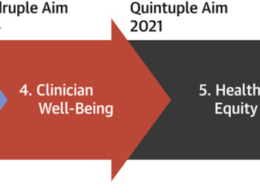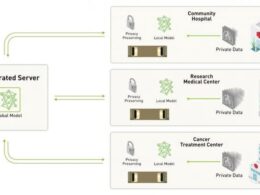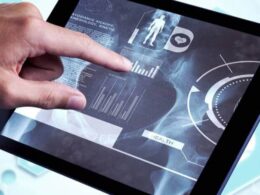NEJM
Isaac Kohane, M.D., Ph.D., and Gilbert S. Omenn, M.D., Ph.D.
August 11, 2022
This site version was edited by:
Joaquim Cardoso MSc.
Transformation Institute — Health System Transformation
Data Driven Health Care Unit
August 10, 2022, gcn
Imagine if we could track, for each patient seen at a health care facility, which Covid-19 vaccine they had received when and what their clinical evaluation revealed.
We could then have near-real-time insights into the efficacy of vaccines, how that efficacy changes over time, how new viral strains alter it, and which viral and host features (including underlying medical conditions) lead to breakthrough infections in immunized people.
Such tracking would require robust linkage among clinical outcomes (including details of clinical interventions and laboratory studies), data on the specific vaccine administered and the date of administration, and information about the status of the pandemic in the relevant geographic area.
This effort is not an act of futuristic visioning.
Tightly integrated population-based health care organizations in countries such as Israel have directly informed public health policies such as recommendations for a third, boosting vaccination, at the scale of several million people.1
Unfortunately, these successes accentuate the relative failures in linking public health and health care elsewhere.
Tightly integrated population-based health care organizations in countries such as Israel have directly informed public health policies such as recommendations for a third, boosting vaccination, at the scale of several million people
In most high-income countries, vaccinations are recorded in electronic databases — registries — for public health purposes.
Yet even when patients’ clinical courses are documented in electronic health records (EHRs), information on the relationship between a particular vaccine history and an associated clinical course cannot be readily acquired from the health care system.
We are particularly aware of this challenge in our own work in a growing international voluntary consortium …
… (now including nine countries and 335 hospitals) that has been steadily analyzing clinical Covid trajectories since March 2020 (www.covidclinical.net. opens in new tab).
We have used a variety of analytic and “boots on the ground” data verification and validation techniques to obtain insights into the clinical course of Covid in hospitals over the various waves of the pandemic.2
Nevertheless, we are all too aware of the existing information gaps between public health and clinical care.
Even in countries with universal health identifiers (which the United States lacks) such as France, Singapore, Italy, and Germany, the process of integrating vaccination data with the health record is fraught and often delayed despite multiple national e-health initiatives and the European Commission’s 2018 strategy for digital transformation of health care.
Even in countries with universal health identifiers (which the United States lacks) such as France, Singapore, Italy, and Germany, the process of integrating vaccination data with the health record is fraught and often delayed …
At the same time, several hospital systems, including some in the United States (e.g., Keck Medicine in California3), have closed this gap by implementing homegrown (or EHR-vendor–designed) systems for matching individual clinical records with state or country vaccination registries.
The United Kingdom and the Netherlands have been successful at the national level.4
Although these systems are the exceptions, they demonstrate the feasibility of closing this crucial gap between public health and clinical care.
They also illustrate challenges specific to the United States, where unless patients revisit a hospital for care, data on their immunizations since the last visit, which are stored in a state registry, are not automatically updated in the EHR.

What can we learn from the hospital systems that have closed the gap between immunization registries and their patients’ EHRs?
As summarized in the table, several factors would enable more health systems and governments to close this gap between public health and clinical care in the short term.
None of these desiderata require innovation in technologies or governance, but they do require engagement of local clinical leadership in a dialogue with local public health authorities and a commitment to implement software processes much simpler than those that have been required of EHR vendors or purchasers in the recent past.

Desiderata for Closing the Gap between Clinical and Population Health Data on Covid Vaccination.
Specifically, hospital systems could reach out to their existing patients to ask them to forward any new immunization data …
… (whether images of their immunization record or codified immunization data from increasingly standardized smartphone apps, as in Massachusetts and California).
That way, each hospital would have an authoritative, complete immunization record, including mixes of vaccines, matched to patients’ clinical history — independent of, but complementary to, the most recent patient visit.
To the extent that patients do not participate, adjustments will have to be made to the data.

This proposal is far from a panacea.
The bridgeable gap we describe here is of interest only for countries and health care systems where comprehensive EHR systems have been deployed at scale.
Also, we have not addressed the additional steps that could be taken to further advance public health, such as exporting clinical data from EHRs to state or country registries.
Nor have we tackled aggregating the data on patients’ clinical courses linked to vaccination history in real time across the multiple borders that viruses do not acknowledge but regulations must.
Even more significant are the challenging basic logistics of “last mile” vaccine delivery.5
And we know that some experts would argue that systematic nationwide upgrades of health information infrastructure are preferable to an incremental patchwork approach focused on specific diseases.
Notwithstanding these limitations, we have focused on this small registry–EHR gap because it can readily be filled in the short term, has immediate clinical and public health utility, including catching the potential second surge of omicron infections now emerging in Europe, and can serve as a bridgehead for broader, more ambitious efforts to link clinical medicine and public health in the future.
Author Affiliations
From Harvard Medical School, Boston (I.K.); and the
University of Michigan, Ann Arbor (G.S.O.).
Originally published at https://www.nejm.org.
References
1.Haas EJ, Angulo FJ, McLaughlin JM, et al. Impact and effectiveness of mRNA BNT162b2 vaccine against SARS-CoV-2 infections and COVID-19 cases, hospitalisations, and deaths following a nationwide vaccination campaign in Israel: an observational study using national surveillance data. Lancet 2021;397:1819–1829.
2.Weber GM, Zhang HG, L’Yi S, et al. International changes in COVID-19 clinical trajectories across 315 hospitals and 6 countries: retrospective cohort study. J Med Internet Res 2021;23(10):e31400-e31400.
3.JasonC. Integrating a state vaccine scheduling system into the EHR. EHR Intelligence, May 17, 2021 (https://ehrintelligence.com/news/integrating-a-state-vaccine-scheduling-system-into-the-ehr. opens in new tab).
4.Odone A, Gianfredi V, Sorbello S, et al. The use of digital technologies to support vaccination programmes in Europe: state of the art and best practices from experts’ interviews. Vaccines (Basel) 2021;9:1126–1126.
5.Lee TH, Chen AH. Last-mile logistics of Covid vaccination — the role of health care organizations. N Engl J Med 2021;384:685–687.












